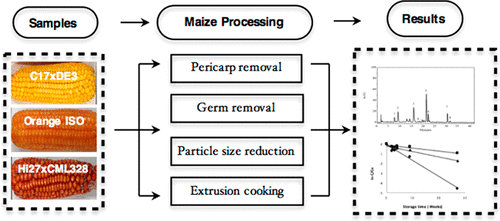当前位置:
X-MOL 学术
›
J. Agric. Food Chem.
›
论文详情
Our official English website, www.x-mol.net, welcomes your
feedback! (Note: you will need to create a separate account there.)
Carotenoid Stability during Dry Milling, Storage, and Extrusion Processing of Biofortified Maize Genotypes
Journal of Agricultural and Food Chemistry ( IF 5.7 ) Pub Date : 2018-03-15 00:00:00 , DOI: 10.1021/acs.jafc.7b05706 Darwin Ortiz , Amudhan Ponrajan , Juan Pablo Bonnet 1 , Torbert Rocheford , Mario G. Ferruzzi 2
Journal of Agricultural and Food Chemistry ( IF 5.7 ) Pub Date : 2018-03-15 00:00:00 , DOI: 10.1021/acs.jafc.7b05706 Darwin Ortiz , Amudhan Ponrajan , Juan Pablo Bonnet 1 , Torbert Rocheford , Mario G. Ferruzzi 2
Affiliation

|
Translation of the breeding efforts designed to biofortify maize (Z. mays) genotypes with higher levels of provitamin A carotenoid (pVAC) content for sub-Saharan Africa is dependent in part on the stability of carotenoids during postharvest through industrial and in-home food processing operations. The purpose of this study was to simulate production of commercial milled products by determining the impact of dry milling and extrusion processing on carotenoid stability in three higher pVAC maize genotypes (C17xDE3, Orange ISO, Hi27xCML328). Pericarp and germ removal of biofortified maize kernels resulted in ∼10% loss of total carotenoids. Separating out the maize flour fraction (<212 μm) resulted in an additional ∼15% loss of total carotenoids. Carotenoid degradation was similar across milled maize fractions. Dry-milled products of Orange ISO and Hi27xCML328 genotypes showed ∼28% pVAC loss after 90-days storage. Genotype C17xDE3, with highest levels of all-trans-β-carotene, showed a 68% pVAC loss after 90-day storage. Extrusion processing conditions were optimal at 35% extrusion moisture, producing fully cooked instant maize flours with high pVAC retention (70–93%). These results support the notion that postharvest losses in maize milled fractions may be dependent, in part, on genotype and that extrusion processing may provide an option for preserving biofortified maize products.
中文翻译:

生物强化玉米基因型在干磨,储藏和挤压加工过程中的类胡萝卜素稳定性
旨在biofortify玉米育种工作的翻译(玉蜀黍)维生素原水平较高的基因型撒哈拉以南非洲的类胡萝卜素(pVAC)含量部分取决于通过工业和家庭食品加工操作进行的收获后类胡萝卜素的稳定性。这项研究的目的是通过确定干磨和挤压加工对三种较高pVAC玉米基因型(C17xDE3,Orange ISO,Hi27xCML328)中类胡萝卜素稳定性的影响,模拟商业化碾磨产品的生产。果皮和生物强化玉米粒的胚芽去除导致总类胡萝卜素损失约10%。分离出玉米粉部分(<212μm)会导致总类胡萝卜素损失约15%。碾磨的玉米各部分的类胡萝卜素降解相似。在储存90天后,Orange ISO和Hi27xCML328基因型的干磨产品显示pVAC损失约28%。所有-反式-β-胡萝卜素在储存90天后显示出68%的pVAC损失。挤出加工条件在挤出水分为35%时是最佳的,可以生产出具有完全pVAC保留率(70-93%)的完全煮熟的速溶玉米粉。这些结果支持了这样的观念,即玉米碾磨部分的收获后损失可能部分取决于基因型,而挤压加工可能为保存生物强化玉米产品提供了一种选择。
更新日期:2018-03-15
中文翻译:

生物强化玉米基因型在干磨,储藏和挤压加工过程中的类胡萝卜素稳定性
旨在biofortify玉米育种工作的翻译(玉蜀黍)维生素原水平较高的基因型撒哈拉以南非洲的类胡萝卜素(pVAC)含量部分取决于通过工业和家庭食品加工操作进行的收获后类胡萝卜素的稳定性。这项研究的目的是通过确定干磨和挤压加工对三种较高pVAC玉米基因型(C17xDE3,Orange ISO,Hi27xCML328)中类胡萝卜素稳定性的影响,模拟商业化碾磨产品的生产。果皮和生物强化玉米粒的胚芽去除导致总类胡萝卜素损失约10%。分离出玉米粉部分(<212μm)会导致总类胡萝卜素损失约15%。碾磨的玉米各部分的类胡萝卜素降解相似。在储存90天后,Orange ISO和Hi27xCML328基因型的干磨产品显示pVAC损失约28%。所有-反式-β-胡萝卜素在储存90天后显示出68%的pVAC损失。挤出加工条件在挤出水分为35%时是最佳的,可以生产出具有完全pVAC保留率(70-93%)的完全煮熟的速溶玉米粉。这些结果支持了这样的观念,即玉米碾磨部分的收获后损失可能部分取决于基因型,而挤压加工可能为保存生物强化玉米产品提供了一种选择。











































 京公网安备 11010802027423号
京公网安备 11010802027423号